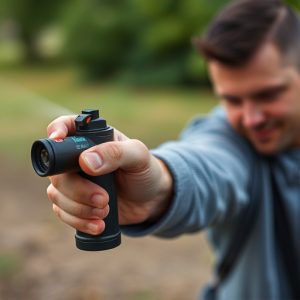Pepper Spray Training for Beginners: Safety Tips for Bear Attacks
For newcomers to pepper spray, especially as a defense against bears, proper training is vital. This…….
For newcomers to pepper spray, especially as a defense against bears, proper training is vital. This includes understanding spray mechanics like range, concentrations, and application techniques, as well as safety measures like protective gear and controlled practice environments. Key focus areas are learning local regulations, tracking bear movement during deployment, and building muscle memory through simulated attack scenarios. Regular sessions enhance calmness and effectiveness in potential wilderness encounters, ensuring beginners can safely utilize pepper spray as a last resort for self-defense.
In the great outdoors, encounters with wildlife can be breathtaking but also dangerous. One such potential menace is the bear, making bear spray a crucial defense mechanism. This article guides you through the essentials of pepper spray training for beginners, focusing on understanding bear spray and its effectiveness against animal attacks. We’ll explore safety tips, techniques, and practical exercises to ensure you’re ready in real-world scenarios, empowering you with the knowledge to protect yourself during your outdoor adventures.
- Understanding Bear Spray: What It Is and How It Works
- Pepper Spray Training for Beginners: Safety Tips and Techniques
- Practicing and Preparing: Effective Use of Bear Spray in Real-World Scenarios
Understanding Bear Spray: What It Is and How It Works
Bear spray, also known as pepper spray, is a specialized defense tool designed to deter and incapacitate aggressive animals, particularly bears. It’s more than just ordinary pepper spray; it’s tailored for outdoor enthusiasts and individuals living in areas where bear encounters are possible. The primary active ingredient in bear spray is capsaicin, which is derived from chili peppers. When used correctly, it can create a temporary but powerful barrier between the user and the attacking animal.
For beginners considering pepper spray training, understanding how bear spray works is crucial. Upon spraying, capsaicin irritates the eyes, nose, and respiratory system of the target animal, causing them to temporarily blinze, sneeze, and cough. This disruption in their sensory perception provides the user with a valuable chance to retreat or fight back effectively. The effect typically lasts for several minutes, allowing individuals to escape potential danger. Proper training involves learning the right distance to deploy the spray and understanding the different bear behaviors to respond accordingly.
Pepper Spray Training for Beginners: Safety Tips and Techniques
For beginners considering pepper spray as a defensive measure against animal attacks, proper training is paramount to ensure its effectiveness and safety. Pepper spray, also known as capsaicin spray, can be a powerful tool when used correctly. Training should start with understanding the spray’s mechanics and limitations. Learn about the different types of pepper spray, their concentrations (often measured in capsaicoin units), and how they work on the body to cause pain and temporary blindness. Familiarize yourself with the spray pattern, range, and the recommended application technique to maximize its impact while minimizing cross-contamination.
Safety tips are crucial during training. Always wear protective gear, including gloves and eye protection, when practicing with pepper spray to avoid accidental exposure. Ensure you’re in a controlled environment, preferably outdoors away from people, pets, and valuable possessions. Learn how to handle the canister responsibly—how to open it safely, how to store it properly between uses, and how to dispose of used canisters according to local regulations. Practice targeting techniques on inanimate objects first, focusing on consistent spray distribution and understanding the effective range. With proper training, beginners can gain confidence in using pepper spray as a last line of defense against animal attacks.
Practicing and Preparing: Effective Use of Bear Spray in Real-World Scenarios
For those new to bear spray, practicing and preparing are crucial steps in ensuring its effective use during a real-world encounter. Pepper spray training for beginners should focus on understanding the spray’s range, wind conditions, and proper application techniques. It’s important to note that practice sessions should simulate actual attack scenarios to build muscle memory. This involves learning how to activate the spray correctly while maintaining awareness of the bear’s position and movement.
During training, beginners should also familiarize themselves with local regulations and guidelines for carrying and using bear spray. Knowing the appropriate distance to deploy the spray, understanding wind patterns, and practicing breathing techniques are essential skills. Regular sessions in controlled environments will enhance one’s ability to respond calmly and effectively when facing a potential bear attack in the wilderness.
Bear spray can be a valuable tool for defending against animal attacks, especially in areas where bears are present. However, effective use requires proper understanding and practice. For those new to bear spray, pepper spray training for beginners is essential to learn safety tips and techniques. By mastering the right techniques through practicing in real-world scenarios, individuals can enhance their chances of staying safe during encounters with these powerful animals. Remember, preparation and knowledge are key when it comes to navigating potential bear encounters.


